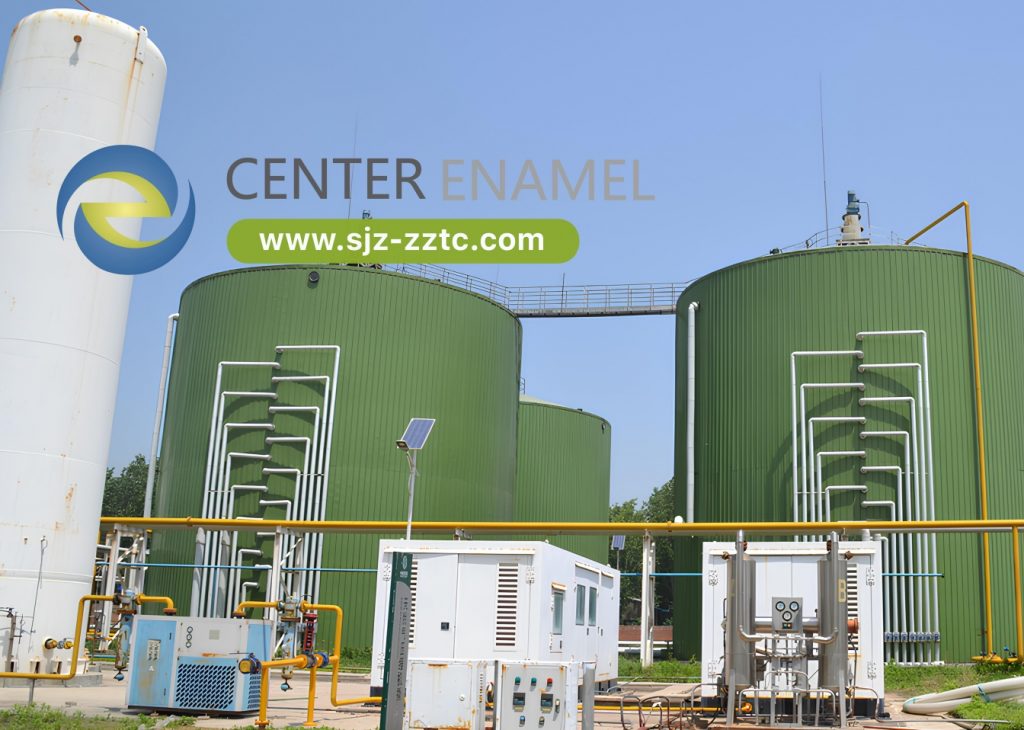CSTRs for Co-Digestion of Livestock Manure and Agricultural Residues | Center Enamel

Modern agricultural operations generate significant volumes of organic waste, including livestock manure and various agricultural residues such as crop stalks, husks, and other plant materials. When managed properly, these materials can be converted into renewable energy. However, using a single substrate often leads to suboptimal nutrient balance and variable biogas yields. Co-digestion addresses these challenges by combining different organic wastes to:
- Improve the Carbon-to-Nitrogen (C/N) Ratio: Balancing high-nitrogen manure with carbon-rich residues can stabilize microbial activity.
- Enhance Biogas Yields: A mixed substrate provides a more balanced feedstock, leading to improved methane production.
- Mitigate Inhibitory Effects: Dilution of potentially inhibitory compounds in manure with agricultural residues can reduce process disturbances.
- Optimize Resource Use: Co-digestion creates an opportunity to valorize multiple waste streams, thereby improving overall process economics and reducing environmental impacts.
Continuous Stirred Tank Reactors (CSTRs) offer an effective and scalable solution for the co-digestion of livestock manure with agricultural residues. Center Enamel provides advanced CSTR systems designed to optimize biogas production, improve process stability, and enhance the overall efficiency of anaerobic digestion processes.
Advantages of Continuous Stirred Tank Reactors (CSTRs)
CSTRs have become the industry standard for anaerobic digestion due to their design flexibility and robust performance. The main advantages of employing CSTRs for co-digestion include:
- Homogeneous Mixing:
Continuous stirring ensures that all substrates are uniformly mixed, which enhances contact between microbes and organic matter. This even distribution is critical for maximizing biogas production and ensuring process stability. - Flexible Retention Times:
CSTRs allow for precise control over hydraulic retention time (HRT) and solids retention time (SRT), enabling operators to optimize conditions for the diverse substrates involved in co-digestion. This flexibility is particularly important when processing substrates with varying degradation rates. - Scalability:
The modular design of CSTRs makes them suitable for a range of scales—from small farm installations to large industrial plants. This scalability allows operators to adjust reactor capacity in line with available feedstock and energy demands. - Enhanced Process Control:
CSTR systems facilitate real-time monitoring and automated control of critical process parameters such as temperature, pH, and organic loading rate. This level of control is essential for maintaining optimal conditions for anaerobic microbial communities, thus ensuring consistent performance and high biogas yields. - Robustness in Variable Feedstock Conditions:
Given the inherent variability in livestock manure and agricultural residues, CSTRs offer a robust solution by accommodating fluctuations in substrate composition. Their continuous operation mode minimizes the impact of feedstock variability on overall process performance.
Center Enamel’s Approach to CSTR Technology
At Center Enamel, our CSTR systems are engineered with an emphasis on durability, precision, and operational efficiency. Our design philosophy integrates the latest advancements in process engineering with a deep understanding of the unique challenges faced by the agricultural and livestock sectors.
Design and Material Excellence:
Our reactors are constructed using high-quality, corrosion-resistant materials that withstand the harsh conditions typically encountered in anaerobic digestion. The robust design ensures longevity and minimal maintenance requirements, even in challenging environments. This commitment to material excellence translates into long-term cost savings and reliable operation.
Advanced Process Integration:
Center Enamel’s CSTRs are equipped with state-of-the-art control systems that facilitate automated monitoring and adjustment of key process parameters. This advanced integration not only enhances process stability but also maximizes biogas production efficiency. Our systems are designed to seamlessly integrate with other components of the biogas production chain, such as gas storage and upgrading units, thereby creating a cohesive solution for renewable energy generation.
Customization for Optimal Performance:
Understanding that each agricultural operation has unique requirements, we offer customizable CSTR solutions tailored to specific feedstock characteristics and production goals. Our engineering team collaborates closely with clients to design reactors that meet local regulatory standards and operational demands. This bespoke approach ensures that our systems deliver optimal performance regardless of scale or substrate variability.
Economic and Environmental Benefits
The co-digestion of livestock manure with agricultural residues using CSTR technology offers both significant economic and environmental advantages:
- Increased Energy Recovery:
Optimized substrate mixing in a well-controlled reactor environment leads to higher biogas yields, which can be used to generate electricity, heat, or be upgraded to biomethane. This increased energy recovery can reduce reliance on conventional fossil fuels and lower energy costs. - Reduction in Greenhouse Gas Emissions:
By capturing methane—a potent greenhouse gas—that would otherwise be emitted from untreated manure, CSTR-based co-digestion contributes to a lower carbon footprint. This environmental benefit is especially valuable in the context of increasingly stringent emissions regulations. - Enhanced Waste Management:
Converting waste into energy not only reduces environmental pollution but also transforms a liability into a valuable resource. The nutrient-rich digestate produced as a by-product can be used as an organic fertilizer, promoting sustainable agricultural practices and closing the nutrient loop. - Operational Efficiency and Cost Savings:
The robust design and automated control systems of Center Enamel’s CSTRs reduce downtime and maintenance costs, thereby enhancing overall process efficiency. The scalability and flexibility of our systems also allow for incremental expansion, making them a cost-effective solution for diverse operational scales.
For agricultural operators and livestock producers interested in improving their biogas production and waste management practices, Center Enamel’s CSTR solutions provide a reliable, efficient, and scalable technology platform. Contact us today to learn how our tailored anaerobic digestion systems can support your operational goals and contribute to a more sustainable agricultural future.
